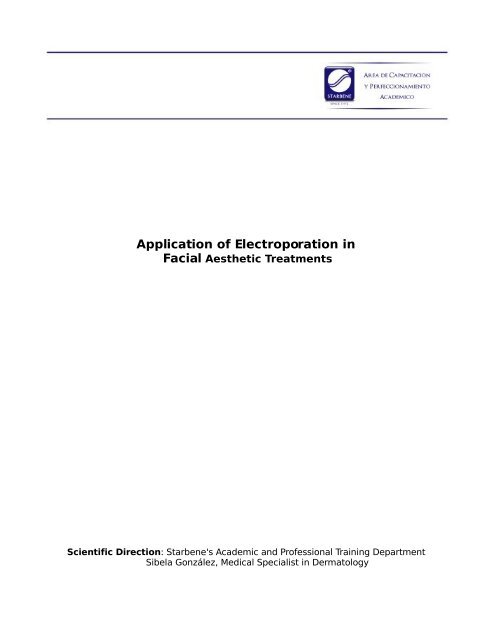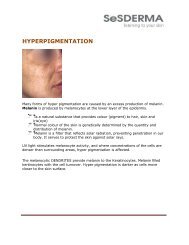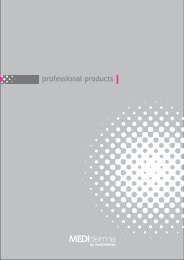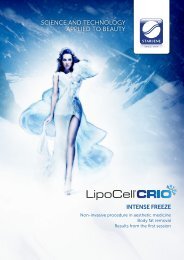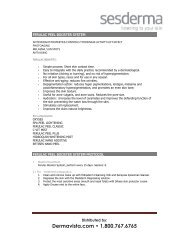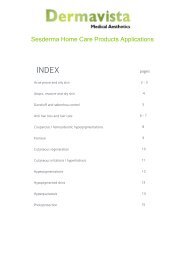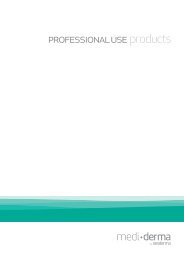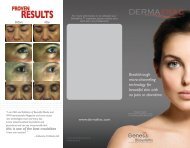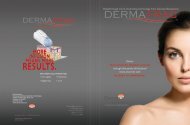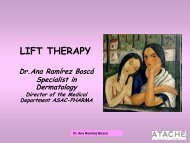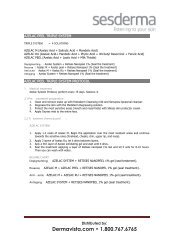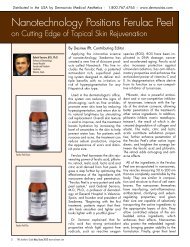Application of Electroporation in - Dermavista.com
Application of Electroporation in - Dermavista.com
Application of Electroporation in - Dermavista.com
Create successful ePaper yourself
Turn your PDF publications into a flip-book with our unique Google optimized e-Paper software.
Introduction<strong>Electroporation</strong> :It is a mechanism <strong>of</strong> transdermic adm<strong>in</strong>istration <strong>of</strong> active substances through low-frequency currentsand high voltage (faradic) currents capable <strong>of</strong> <strong>in</strong>crement<strong>in</strong>g the cellular membrane's permeability,alter<strong>in</strong>g the phospholipidic two-layer structure and produc<strong>in</strong>g temporary and reversible pores.BIO STIM features microcurrents to favor the penetration <strong>of</strong> ionizable active pr<strong>in</strong>ciples, optimiz<strong>in</strong>gresults.This technology takes advantage <strong>of</strong> the cellular membrane's weakness and its capacity <strong>of</strong> recover<strong>in</strong>gafter the electrical impulse that produces the pores' open<strong>in</strong>g.Mechanism <strong>of</strong> Entrance :<strong>Electroporation</strong> allows for the arrival <strong>of</strong> the product to the dermis (as mesotherapy).The dermis is the sk<strong>in</strong> layer more vascularised, and as such, has the function <strong>of</strong> absorb<strong>in</strong>g andredistribut<strong>in</strong>g medic<strong>in</strong>es. Besides, its structure eases this spread<strong>in</strong>g <strong>in</strong> a susta<strong>in</strong>ed and prolongedway.First, the mechanism <strong>of</strong> <strong>in</strong>troduction is transepidermic and transfollicular. Once <strong>in</strong> the sk<strong>in</strong>, itbe<strong>com</strong>es transcellular and <strong>in</strong>tercellular, be<strong>in</strong>g the latter the most important. F<strong>in</strong>ally, the productgoes <strong>in</strong>to the <strong>in</strong>tracellular space for a difference <strong>in</strong> the concentration gradient.In different studies, there has been described the pass<strong>in</strong>g <strong>of</strong> particles from 0,2 µm, 4 µm and even,45 µm.In other study conducted by TDES, it is established that the <strong>in</strong>tercellular spaces provoked by theapplication <strong>of</strong> pulses adapt their diameter accord<strong>in</strong>g to the size <strong>of</strong> the particles go<strong>in</strong>g through them(the diameter <strong>of</strong> the spaces between 2 cells be<strong>in</strong>g from 0,8 µm to 3,1 µm, and the diameter <strong>of</strong> theparticles <strong>of</strong> ch<strong>in</strong>ese <strong>in</strong>k be<strong>in</strong>g <strong>of</strong> 0,15 µm)This phenomenon is created with short pulses (1,2 msec) <strong>of</strong> high voltage (120 V).In the same study, there can be seen particles <strong>of</strong> ch<strong>in</strong>ese <strong>in</strong>k <strong>in</strong> the cornea surface, follicular pores,kerat<strong>in</strong>ocytes cytoplasm, <strong>in</strong> all the layers <strong>of</strong> the epidermis and the papillary (superficial) and reticular(deep) dermis, without the necessity <strong>of</strong> apply<strong>in</strong>g a keratolytic agent (urea, salicylic or lactic acid,among others).
Photoage<strong>in</strong>gIt is a multifactorial, dynamic and <strong>com</strong>plex process, that <strong>com</strong>b<strong>in</strong>es <strong>in</strong>tr<strong>in</strong>sic (genetic,nutritional or hormonal) and extr<strong>in</strong>sic (ultraviolet rays, smok<strong>in</strong>g, heat, cold) factors .The result<strong>in</strong>g are cutaneous modifications such as dehydration, wr<strong>in</strong>kles and flabb<strong>in</strong>ess.There is a classification proposed by Glogav <strong>in</strong> 1990 that considers age<strong>in</strong>g levels depend<strong>in</strong>g on thepresence <strong>of</strong> keratosis, wr<strong>in</strong>kles and dyschroa.Glogav ClassificationAge<strong>in</strong>g Act<strong>in</strong>ic Keratosis Wr<strong>in</strong>kles DichromiesSlight (25 to 35) - Few M<strong>in</strong>imumModerate (35 to 45) + Dynamic BrownishAdvanced (45 to 60) ++ At rest Yellowish BrownishSevere (60 to 75) +++ Gravitational TelangiectasiasTRANSDERMIC ADMINISTRATION VIA ELECTROPORATION IN THE TREATMENT OFCUTANEOUS AGEINGThe case study was performed with a total <strong>of</strong> 6 patients.Inclusion Criteria:-Women-Age between 40 and 60 years-Cutaneous Flabb<strong>in</strong>ess-Cutaneous Age<strong>in</strong>g.Exclusion Criteria:-Under cosmetologic treatment.-Facial Aesthetic Surgery <strong>in</strong> the last 12 months.-Active Sk<strong>in</strong> Lesions.-Pacemakers.-Epilepsy.-TAH (Total Abdom<strong>in</strong>al Hysterectomy).-Pregnancy.-Cardiopathies.
Diagnoses :-Cl<strong>in</strong>ical Evaluation, preparation <strong>of</strong> Cl<strong>in</strong>ical Record.-Hydration and Elasticity with Multidermascope MDS-800.-Photographic Record.-Ecographic Record.General Objectives:- Indirectly prove the effect <strong>of</strong> substances <strong>in</strong>troduced <strong>in</strong>to the organism through <strong>Electroporation</strong>, forthe treatment <strong>of</strong> photoage<strong>in</strong>g and cutaneous flabb<strong>in</strong>ess.- Produce subjective changes (reduc<strong>in</strong>g wr<strong>in</strong>kles, provid<strong>in</strong>g more firmness to the sk<strong>in</strong>, improve thequality and the sk<strong>in</strong> appearance)Specific Objectives:●●Improve the sk<strong>in</strong> appearance.Dim<strong>in</strong>ish the evidences <strong>of</strong> age and cutaneous flabb<strong>in</strong>ess.Intervention :It was used the Biostim equipment, made by Starbene, Europa L<strong>in</strong>e, serial nº PR 0001.It was performed the sensitivity test, apply<strong>in</strong>g a drop <strong>of</strong> the product on the sk<strong>in</strong> <strong>of</strong> the <strong>in</strong>ner forearm,24 hs before the beg<strong>in</strong>n<strong>in</strong>g <strong>of</strong> the treatment. It was applied 1,5 cc per area <strong>of</strong> 10 per 15 cm (total 3cc per session) <strong>of</strong> the solution <strong>of</strong> active substances (DMAE 1% + hyaluronic acid 0,1% + Colagen 5%+ ELECTROPORATION SPECIAL VEHICLE), <strong>of</strong> lipolytic and anticellulitic action, through electroporation,previously apply<strong>in</strong>g an antiseptic substance.It was <strong>in</strong>dicated a solar protector and extreme prevention when exposed to the sun.Duration <strong>of</strong> the Session:7 to 12 m<strong>in</strong>utes.Duration <strong>of</strong> the treatment:10 sessions dur<strong>in</strong>g 5 weeks.Frequency <strong>of</strong> <strong>Application</strong>:The frequency <strong>of</strong> application was <strong>of</strong> 2 sessions per week with an <strong>in</strong>terval <strong>of</strong> 2 or 3 days <strong>in</strong> between.Statistical AnalysisMultidermascope MDS-800
Multidermascope MDS-800 is the tool used <strong>in</strong> the case study for the sk<strong>in</strong> diagnoses. It featuresvarious measur<strong>in</strong>g probes:Hydration - CorneometerElasticity - CutometerCapacitancePressure: approx. 0,16 N/49 mm²Frequency: 0,9 – 1,2 Mhz.Suction Pr<strong>in</strong>cipleOpen<strong>in</strong>g: 2 mm diámetroTime <strong>of</strong> Measurement: 6 seconds.Results :All the patients experienced subjective and objective improvements.It was evident a noticeable attenuation <strong>of</strong> the expression grooves. The sk<strong>in</strong> presented morefirmness at palpation.Elasticity, hydration, the sk<strong>in</strong> quality and the general appearance <strong>of</strong> the face improved <strong>in</strong> all thecases.There were registered changes from the fifth session.Measur<strong>in</strong>g Record with Sk<strong>in</strong> Analyser (Multidermascope MDS-800)HydrationbeforeHidrationafterElasticitybeforeElasticityafterp 1 80 99 49 53p 2 83 87 54 67p 3 85 90 71 78p 4 99 99 41 63p 5 86 95 59 76p 6 82 89 48 65Modification AveragesHydration : 7,33Elasticity : 13,33
Patient 3Patient 4
Adverse Reactions:Pa<strong>in</strong>ful sensation due to the excitation <strong>of</strong> nerves and proximal muscles, itch, t<strong>in</strong>gl<strong>in</strong>g, erythema anddim<strong>in</strong>ish<strong>in</strong>g <strong>of</strong> the electrical resistance <strong>of</strong> the sk<strong>in</strong> under treatment (all the patients endured less thepass<strong>in</strong>g <strong>of</strong> the current along the treatment), this reactions are slight, reversible and temporary.At a histological level and after apply<strong>in</strong>g <strong>Electroporation</strong> for 12 m<strong>in</strong>utes, there have not beenregistered tissular alterations, not even the slightest ones such as tumefaction or cytoplasmatic ororganelle vacuolization nor irregularity <strong>of</strong> the nuclear and cellular membranes.Discussion:The ma<strong>in</strong> <strong>in</strong>convenience presented by the topical adm<strong>in</strong>istration <strong>of</strong> active pr<strong>in</strong>ciples is the barrierposed by the sk<strong>in</strong> to any external substance. This new and revolutionary technique <strong>in</strong> Aestheticsmultiplies the effects and optimizes the results <strong>of</strong> topical applications and <strong>of</strong> ionization <strong>of</strong> cosmetics,s<strong>in</strong>ce it allows for the <strong>in</strong>corporation to deep sk<strong>in</strong> layers <strong>of</strong> active pr<strong>in</strong>ciples that cannot penetratethe corneal surface by other means.It is possible then, to use specific drugs to treat flabb<strong>in</strong>ess or cutaneous age<strong>in</strong>g.Conclusion:The measurement carried out with the sk<strong>in</strong> analyser MDS-800 showed <strong>in</strong> 100 % <strong>of</strong> the cases anoticeable improvement regard<strong>in</strong>g sk<strong>in</strong> hydration and moisturiz<strong>in</strong>g.All the patients noticed positive changes <strong>in</strong> the sk<strong>in</strong> quality, stat<strong>in</strong>g that “they look younger”.Bio Stim was efficient <strong>in</strong> the treatment <strong>of</strong> aged sk<strong>in</strong>s, attenuat<strong>in</strong>g wr<strong>in</strong>kles and expression groovesand <strong>in</strong>crement<strong>in</strong>g hydration and elasticity.It can be mentioned that <strong>in</strong> all the cases there was registered an improvement <strong>in</strong> the sk<strong>in</strong> quality,chang<strong>in</strong>g the general appearance <strong>of</strong> the face, which was evident after the fifth session and morenoticeable at the end <strong>of</strong> the treatment.Hydration and elasticity <strong>in</strong>cremented values, as well as photographic records and the patient's oralaccounts prove the effectiveness <strong>of</strong> Bio Stim's <strong>Electroporation</strong> to <strong>in</strong>troduce specific substances <strong>in</strong>tothe organism, optimiz<strong>in</strong>g their action.Scientific Direction: Sibela González, Medical Specialist <strong>in</strong> Dermatology.Member <strong>of</strong> the Dermatology Department <strong>of</strong> the Hospital Nacional de Clínicas, Córdoba, Argent<strong>in</strong>a.Colaborators: María Gabriela Ruiz, Physiotherapy and K<strong>in</strong>esiology Licenciate. Andrés S. Val<strong>in</strong>otti,Physiotherapy and K<strong>in</strong>esiology Licenciate. Damián A. Torletti, Physiotherapy and K<strong>in</strong>esiology Licenciate.Jimena Quagliotti, Apparatology Technician.


